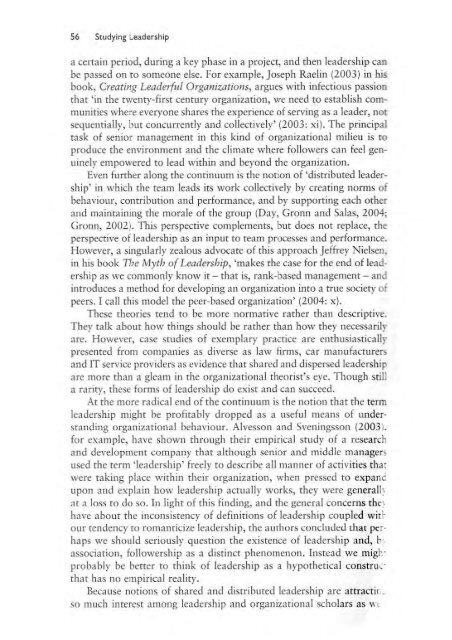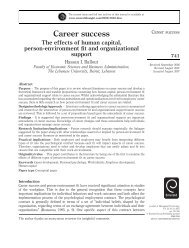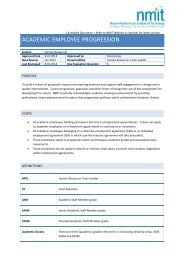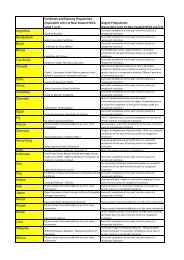Jackson Parry - Leadership, Chp 3, 41-60.pdf
Jackson Parry - Leadership, Chp 3, 41-60.pdf
Jackson Parry - Leadership, Chp 3, 41-60.pdf
- No tags were found...
Create successful ePaper yourself
Turn your PDF publications into a flip-book with our unique Google optimized e-Paper software.
S6Studying <strong>Leadership</strong>a certain period, during a key phase in a project, and then leadership canbe passed on to someone else. For example, Joseph Raelin (2003) in hisbook, Creating Leaderful Organizations, argues with infcctiolls passionthat 'in the twenty-first century organization, we need to establish communitieswhere everyone shares the experience of serving as a leader, notsequentially, but concurrently and collectively' (2003: xi). The principaltask of senior management in th is kind of organiza tional mi lieu is toproduce the environment and the climate where followers can feel genuinelyempowered to lead within and beyond the organization.Even further along the continuum is the notion of 'distributed leadership'in which the team leads its work collectively by creati ng norms ofbehaviour, contribution and performance, and by supporting each otherand maintaining the morale of the group (Day, Gronn and Salas, 2004;Gronll, 2002). This perspective complements, but docs not replace, t h~perspective of leadership as an input to team processes and performance.However, a singularly zealous advocate of this approach Jeffrey Nielsen,in his book The Myth of <strong>Leadership</strong>, 'makes the case for the end of leadershipas we commonly know it - that is, rank-based management - andintroduces a method for developing an organization into a true society ofpeers. I call this model the peer-based organization' (2004: x).These theories tend to be more normative rather than descriptive.They talk about how things should be rather than how the)' necessarilyare. However, case studies of exemplary pracrice arc enthusiasticallypresented from companies as di verse as law firms, car manufacturersand IT service providers as evidence that shared and dispersed leadershipare more than a gleam in the organizational theorist's eye. Though stilla rarit)" these forms of leadership do exist and can succeed .At the morc radical end of the continuum is the notion that the te rmleadership might be profitably dropped as a useful means of under·standing organizational behaviour. Alvesson and Sveningsson (2003).for exa mple, have shown th rough their empirical study of a researchand development company that although senior and middle managersused the term 'leadership' freel), to describe all manner of activities tharwere raking place within their organization, when pressed to expancupon and explai n how leadership actually works, they were ge ncra ll ~at a loss to do so. Tn light of this finding, and the general concerns t h e ~have about the inconsistency of definitions of leadersh ip coupled witl·our tendency to romanticize leadership, rhe aUThors concluJeJ that per·haps we should seriously question the existence of leadership and, b:,association, followership as a distinct phenomenon. Instead we migh·probably be better to think of leadership as a hypothetical construethat has no empirical reality.Because notions of shared and distributed leadership are attractil'_so much interest among leadership and organizational scholars as W L
















